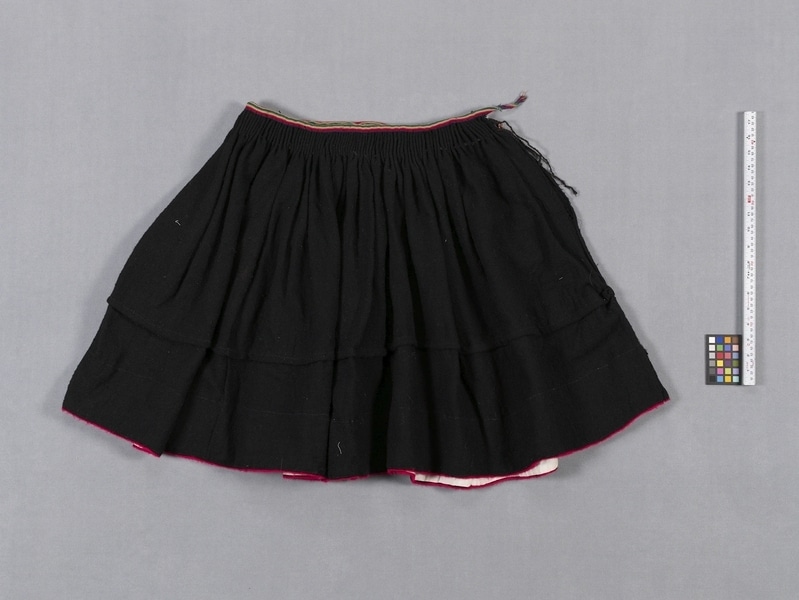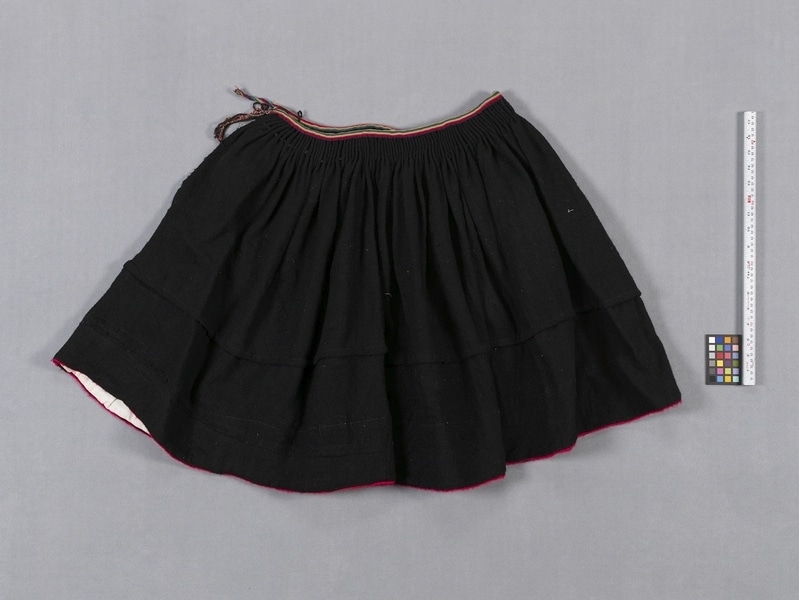Skirt Item Number: Sf958 from the MOA: University of British Columbia


Description
Skirt made of black fabric and gathered at the waist with hot pink piping at the hem and a multicoloured striped band for a waistband. There is an opening at the top of one seam with ties extending from the waistband. One horizontal pleat 20 cm above the hem. To the right of the seam that leads to the opening in the waistband, a piece of fabric has been added at the hem to extend the height of the existing fabric. The back left loom width is pieced together just above the hem.
History Of Use
Bayeta is made by males on the treadle loom and is used for garments that are cut to size and sewn, such as trousers, shirts, skirts and vests. The style, the construction and and the loom used are non-indigenous and derive from Spanish peasant tradition. Handspun sheep's wool is the traditional material, but synthetic yarns are now used. Black is the most common colour worn by women on a daily basis. For fiestas and special ceremonies, many skirts are worn layered. Unmarried girls sometimes pin the hem of the outer black skirt to the waist to show a red skirt worn underneath.
Cultural Context
everyday
Narrative
Bought from Gonzalo Yucra Huatta who spun, wove and sewed the skirt for his wife, Pelagia Quispe Cruz. He said it was almost new and so did not need washing, although there are some spots on it.
Specific Techniques
Balanced plain woven fabric made from sheep's wool yarns, z-spun singles. Waistband is warp-faced plain weave made from overtwisted synthetic yarns, z-spun and s-plied. Hem facing is commercial balanced weave cloth, perhaps cotton. 5 loom widths are cut and machine stitched together and the waist is gathered with 2 rows of running stitches. The waistband is hand sewn. Hem piping and facing are machine stitched.
Item History
- Made by Gonzalo Yucra Huatta (Maker) in Taquile, Puno, Peru during 1982
- Collected by Mary Frame during 1982
- Owned by Mary Frame before February 10, 1983
- Received from Mary Frame (Seller) and Museum of Anthropology Shop Volunteers (Funding source) on February 10, 1983
What
- Name
- Skirt
- Identification Number
- Sf958
- Type of Item
- skirt
- Material
- wool fibre, synthetic fibre and dye
- Manufacturing Technique
- woven, sewn, retwisted, braided and spun
- Overall
- height 68.0 cm, width 139.0 cm, depth 2.3 cm
Who
- Culture
- Quechua
- Creator
- Gonzalo Yucra Huatta (Maker)
- Field Collector
- Mary Frame
- Previous Owner
- Mary Frame
- Received from
- Mary Frame (Seller) and Museum of Anthropology Shop Volunteers (Funding source)
Where
- Holding Institution
- MOA: University of British Columbia
- Made in
- Taquile, Puno, Peru
When
- Creation Date
- during 1982
- Collection Date
- during 1982
- Ownership Date
- before February 10, 1983
- Acquisition Date
- on February 10, 1983
Other
- Item Classes
- textiles
- Condition
- good
- Accession Number
- 0861/0017